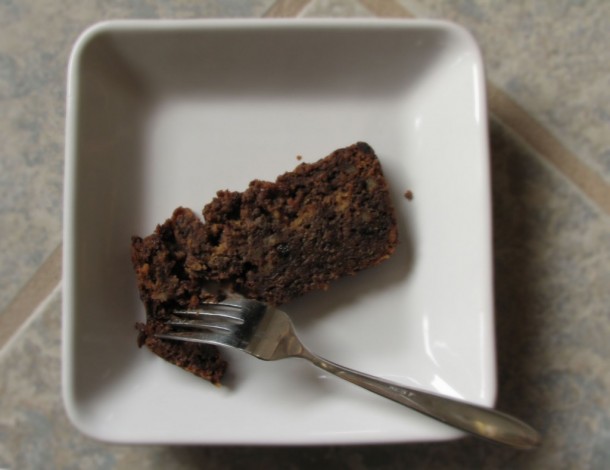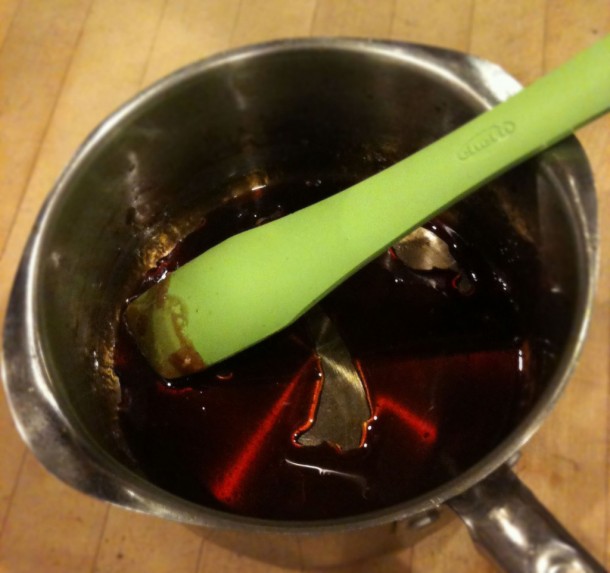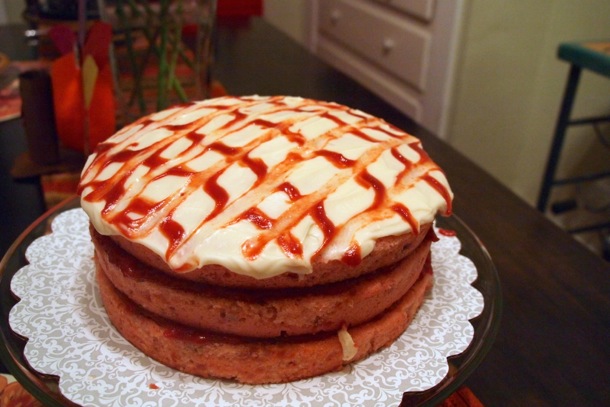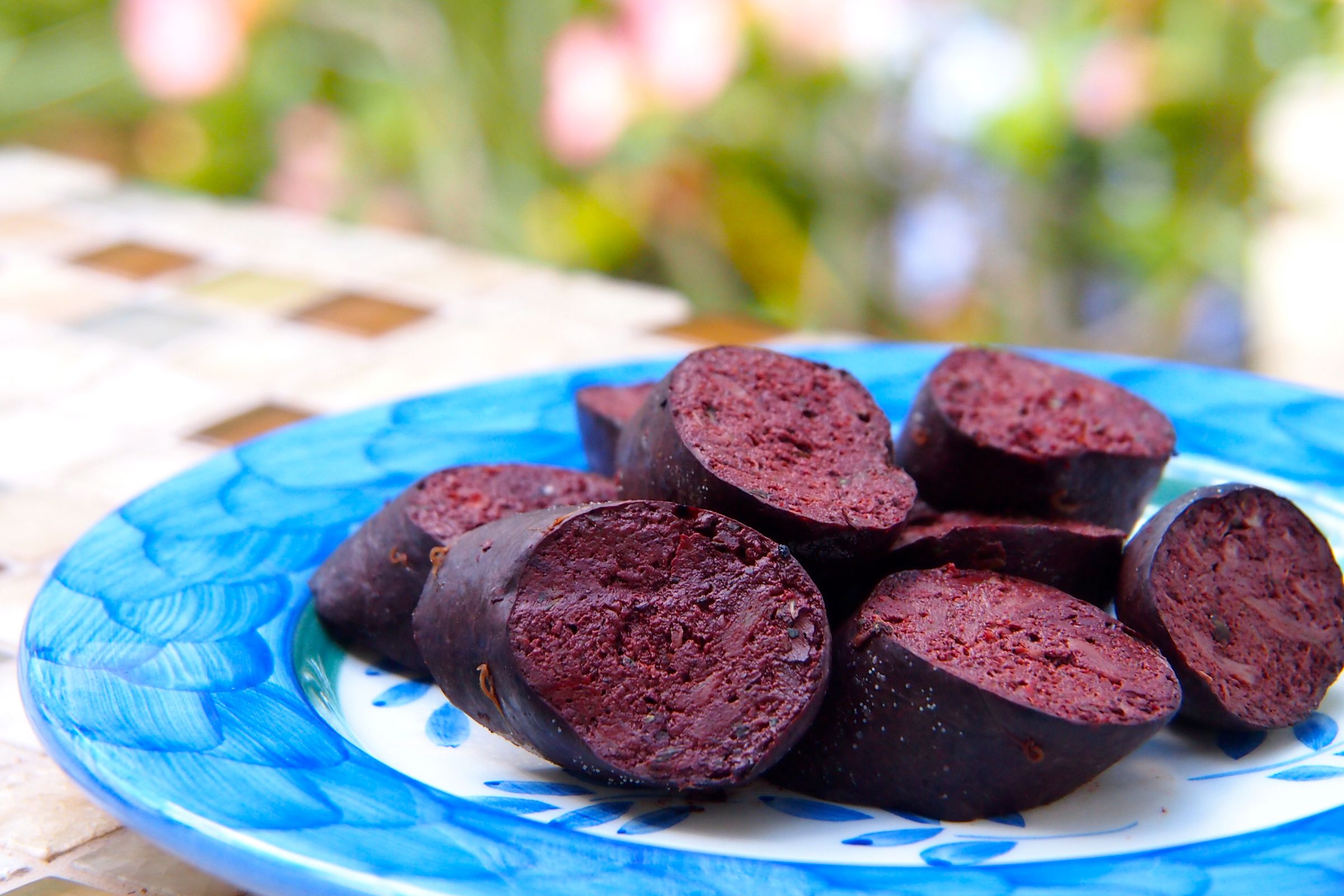Black Cake by Way of Brooklyn: Taste of the Caribbean
Note: This is a guest post from our good friend and certified dessert whiz, Renee Bauman. Renee graduated from the French Culinary Institute’s Pastry Program and has worked in several notable New York restaurants. You may know her as the architect of last year’s gingerbread brownstone and this year’s gingerbread Brooklyn block. Here, she presents her take on a West Indian holiday staple: black cake. Please make her feel welcome.

Nothing says wintry decadence like dried fruits and nuts soaked in rum. And don’t worry if you normally hate fruitcake; unless you grew up in the Caribbean, this isn’t your grandma’s fruitcake. Admittedly I’m a teensy bit obsessed with regional variations on fruitcake (and there are so many interesting cakes out there). But even in a field of many wonderful winter fruitcakes, this one is truly unique.
- Rum-Soaked Fruit:
- 4 c. dark-colored dried fruit (prunes, raisins, sweet cherries and currants)
- 1 1/3 c. dried sour cherries
- 1/3 c. candied orange peel
- 1/3 c. almonds
- 1 c. dark rum
- Caramel:
- 1/3 c. sugar
- 1/4 c. water
- Cake:
- 1 c. butter (2 sticks)
- 1 c. dark brown sugar
- the zest from 2 limes
- 1 t. Angostura bitters
- 1/2 t. salt
- 5 eggs
- 2 c. flour
- 2 t. baking powder
- 1 t. cinnamon
- Soaking Liquid:
- 1 c. combined rum, sherry and brandy
- Yield:
- (2) 9 1/2″ X 4″ loaves
Enter black cake, the amazingly delicious fruitcake of the Caribbean. Black cake is a descendant of the English Christmas pudding which has been infused with Caribbean ingredients, tastes and a certain tropical joie de vivre. I knew that I was going to love this cake before I’d tasted it, and not just because of the raves about black cake’s mellow-yet-wildly-fruity taste. The techniques and ingredients were interesting and unique enough to push all of my pastry geek buttons. The backbone of black cake is the fruit. Rather than the garish preserved fruits typical of American fruitcake, black cake highlights the unheralded dark dried fruits: dried prunes, currants and raisins. Then sugar (a local ingredient for Caribbean bakers) is utilized in many forms: brown sugar, white sugar cooked to a dark caramel, and finally fermented sugar, or rum, is used to soak the fruit before baking, and the whole cake afterward. The cake bakes at a very low temperature for a long time, which is typical of the English Christmas pudding, and also helps to gently bake all of that dried fruit. Afterward the whole thing is doused in a mixture of rum, brandy and sherry.
I adapted this recipe from one given to me by the lovely folks at Uncommon Caribbean. I futzed with the technique a little bit, scaled it down and made a few substitutions for ingredients that might be hard to find in an American grocery store. And I couldn’t resist adding the Caribbean specialty, angostura bitters, that some recipes call for.
Soak fruit.
Measure out all of your dried fruit and nuts. Place all of the dried fruit and rum into a sturdy, sealable plastic bag. Try to squeeze out as much air as possible so that the fruit is submerged in rum. Leave out at room temperature for at least two days. Potentially, you could soak your fruit months before baking.
Cook caramel:
Pour sugar into a stainless steel saucepan (avoid dark colored pans so you can see the caramel’s color as it cooks). Measure your water and keep it near the stovetop. Place saucepan on high heat. Once the sugar starts to melt, stir it with a wooden spoon or heat resistant silicone spatula.Continue stirring as the sugar starts to darken– you want the whole mass to color evenly, so watch for any areas that might want to burn quickly. The caramel needs to cook to a dark mahogany color, as dark as you can cook a caramel without burning it. *At this point, the caramel will start to froth and bubble vigorously. When it has reached the proper color, hold the pan away from you and pour in the water all at once. The extremely hot sugar will instantly boil the water and release a lot of steam. Once the hissing and steam has subsided stir the caramel and water until all of the caramel has been dissolved. Bring the mixture back to a boil for a minute or so, then let it cool. When cool it should be about the consistency of honey or molasses and have a strong, slightly bitter caramel flavor. You may make this caramel sauce a day or two ahead.

Purée fruit:
When you are ready to mix and bake your cakes, place all of your soaked fruit and nuts in the bowl of a food processor. Purée until the mix is mostly pulverized. This step is optional, you could also chop your fruit up by hand, but I like the rich, soft texture you get when the fruit works it’s way into the crumb of the cake. I look for mostly pulverized fruit with some smaller chunks remaining for variation in texture.
Cream butter:
Put room temperature butter in the bowl of a mixer and beat together with salt, brown sugar, bitters and lime zest. Once the butter and sugar mixture is well incorporated, add eggs one at a time. Wait until each egg has been fully incorporated into the mix before adding the next.
Prepare baking pan:
Brush two loaf pans thoroughly with butter. I like to use the wrappers from the sticks of butter. Preheat the oven to 250 F.
Mix batter:
In a separate bowl, whisk together flour, baking powder and cinnamon. Take the bowl with the butter/sugar mixture and add half of the fruit puree and half of the flour mixture. Fold the ingredients together with a spatula. Add the remaining puree and flour mixture and fold together until all elements are mixed thoroughly. Pour into prepared loaf pans.
Bake:
in a 250 F oven for 1 hour. Reduce the heat to 225 and continue cooking for an hour and a half or until a wooden skewer inserted into the center of the loaf comes out clean.
Soak:
Transfer the cakes (still in their pans) to a cooling rack. When the cakes have mostly cooled, use the skewer to prick a number of holes into the cake. Pour the mixed liquors over the surface of the cake several times as the cakes cool. When the cakes are thoroughly cooled, delicately remove them from the pans.
Serve:
This cake is very dense and rich, so even thin slices feel like a special treat. You can bake the cakes well in advance of when you plan to eat them, and periodically soak them with rum if they begin to dry out.
Enjoy!
*Restaurant chefs call this technique of cooking dry sugar a “dry caramel”. If you live in the Caribbean, you can skip this whole step and just add some store-bought browning. But now you know how to make browning the old fashioned way, so feel free to be a little smug about it.



